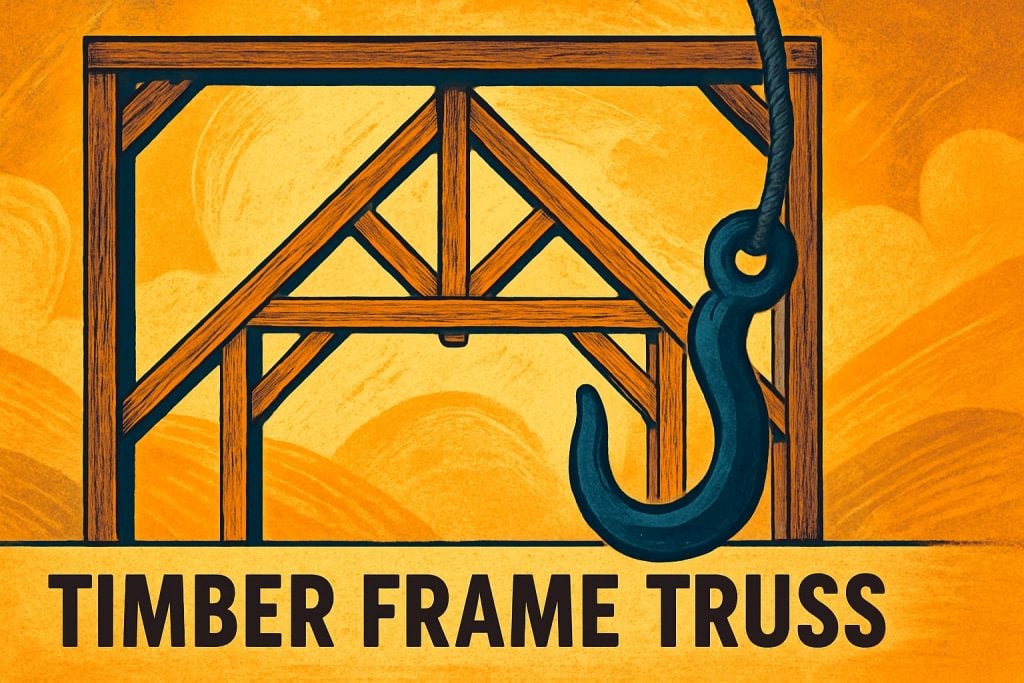Timber frame truss construction is experiencing a remarkable resurgence as we approach 2025, with new innovations transforming modern building design. This guide offers expert insights into timber frame truss systems, exploring the latest trends, advanced materials, design principles, and updated construction standards shaping the future.
In the sections ahead, you will discover the fundamentals of timber frame truss, explore classic and contemporary design types, compare material choices, and gain practical advice on engineering, installation, and sustainability. Are you ready to see how timber frame truss solutions are redefining architecture and building performance for the next generation?
Timber Frame Truss Fundamentals: Structure, Function & Benefits
Timber frame truss systems are at the heart of both traditional and contemporary construction. Understanding their core structure, function, and benefits is essential for anyone considering timber as a primary building material. This section explores what a timber frame truss is, its advantages, common types, anatomy, and when it is the right choice for your project.

What is a Timber Frame Truss?
A timber frame truss is a structural framework, typically made from heavy timber, designed to support roofs or floors over large spans. These trusses have been used in architecture for centuries, dating back to medieval cathedrals and barns. Their primary function is to distribute loads efficiently across wide spaces, reducing the need for internal walls or columns.
Compared to other framing systems, the timber frame truss offers both robust support and aesthetic appeal. Key terms include chords (main beams), webs (internal supports), and joints (connection points). Today, you will find timber frame truss systems in homes, commercial buildings, and public spaces where open layouts and visible timber are desired.
Key Benefits of Timber Frame Trusses
The timber frame truss delivers outstanding structural integrity, thanks to its efficient load distribution. This makes buildings safer and more durable. Aesthetically, exposed trusses add character and warmth, allowing for versatile design from rustic to ultra-modern.
Speed of construction is another advantage, especially with prefabricated trusses that arrive ready to install. Cost-effectiveness is notable when compared to steel or concrete, particularly for projects seeking a natural look. Additionally, timber frame truss systems offer excellent insulation properties, contributing to energy efficiency and comfort within the building envelope.
Common Timber Truss Types Explained
Several key truss types are used in timber construction. The king post truss, with its central vertical post, is ideal for simple spans. Queen post trusses use two vertical posts for wider roofs. Hammer beam trusses create dramatic open spaces, often seen in heritage projects.
Other designs include scissor trusses, which form vaulted ceilings, raised tie trusses that allow higher walls, and arch-braced trusses for elegant curves. Modern engineered variations use precision-cut timber for bespoke requirements. Each timber frame truss type suits different architectural needs, from classic barns to contemporary homes.
| Truss Type | Key Feature | Typical Use |
|---|---|---|
| King Post | Central vertical | Homes, cottages |
| Queen Post | Dual verticals | Halls, extensions |
| Hammer Beam | Open, decorative | Churches, barns |
| Scissor | Vaulted effect | Living rooms |
| Raised Tie | High wall support | Garages, studios |
| Arch Braced | Curved braces | Grand halls |
Truss Anatomy: Components and Joinery
Each timber frame truss consists of several main components: principal rafters (angled beams), tie beams (horizontal connectors), struts, and braces for stability. Traditional mortise and tenon joints are often used for their strength and craft appeal, while modern trusses may use metal plate connectors.
Fasteners like screws and bolts must meet strict design standards, especially regarding head pull-through capacity. Oriented strand board (OSB) or plywood panels may be integrated to provide additional rigidity and help transfer loads. The anatomy of a timber frame truss blends time-tested joinery with advances in construction technology.
When to Choose Timber Frame Trusses
Choosing a timber frame truss is ideal for projects where open-plan layouts, architectural interest, or sustainable materials are priorities. These trusses suit residential homes, commercial venues, and unique bespoke builds. Site conditions, roof shape, and span requirements all influence suitability.
UK building regulations for 2025 require compliance with updated structural and environmental standards. Notable case studies include modern eco-homes and traditional barns, as well as timber garage and barn designs that showcase the versatility of the timber frame truss. Consulting with experienced professionals ensures your truss solution meets both aesthetic and regulatory demands.
Timber Truss Design: Types, Styles & Architectural Considerations
Timber frame truss design has evolved rapidly, blending tradition and modern innovation. Today’s architects and builders balance classic aesthetics with engineering precision, ensuring each timber frame truss meets both visual and structural demands. The following sections explore design styles, influencing factors, customisation, engineering, construction methods, and expert services for 2025.
Classic and Contemporary Truss Designs
Timber frame truss design offers a rich palette of styles, from the iconic king post and queen post to intricate hammer beam and arch-braced forms. Traditional designs evoke history and craftsmanship, while contemporary trusses adopt minimal lines and open spaces. The choice of style shapes both the interior character and exterior silhouette of a building.
Architectural trends in 2025 continue to favour exposed timber, creating dramatic visual impact and warmth. Designers are drawing inspiration from global movements, blending rustic charm with bold new forms. For further insights into emerging styles and international influences, see Global Timber Frame Trends 2025. Each timber frame truss is selected to complement the building’s function and desired atmosphere.
Factors Influencing Truss Design
Several factors determine the optimal timber frame truss for any project. Span and load requirements are critical, dictating the size and configuration of trusses. Roof pitch and the intended use of the building, such as homes, extensions, or commercial spaces, also play a vital role.
Integration with other elements like SIPs or I-joists can enhance performance and efficiency. Site constraints, climate, and architectural intent further refine the design. By considering these aspects, the timber frame truss can be tailored to meet both structural and aesthetic goals.
Customisation and Bespoke Truss Solutions
Customisation is central to modern timber frame truss design. Clients often seek trusses that reflect unique preferences, architectural themes, or branding. Bespoke solutions may include decorative cut-outs, curved beams, or distinctive joinery.
Collaborating with architects and designers, timber specialists create one-of-a-kind features. Exposed trusses can act as statement pieces, while hidden trusses support complex roof forms. Every timber frame truss project can be adapted for both function and beauty.
Engineering and Structural Calculations
Engineering underpins every timber frame truss, ensuring safety and performance. Structural calculations account for dead and live loads, wind, and snow. Advanced software like CAD and BIM enables precise modelling and visualisation.
Compliance with UK building codes and Eurocode 5 is essential, dictating minimum safety margins and material standards. Engineers use these tools to optimise each timber frame truss, balancing strength, efficiency, and cost.
Prefabricated vs. Site-Built Trusses
Choosing between prefabricated and site-built timber frame truss systems depends on project needs. Prefabrication offers rapid assembly, consistent quality, and minimal waste. Factory-controlled conditions result in precise joinery and efficient use of timber.
Site-built trusses allow for greater flexibility and adaptation to unforeseen site conditions. However, they may require more time and skilled labour. A summary comparison appears below:
| Feature | Prefabricated | Site-Built |
|---|---|---|
| Speed | Fast | Slower |
| Quality Control | High | Variable |
| Flexibility | Limited | High |
| Waste | Low | Moderate |
Selecting the right timber frame truss approach ensures alignment with project timelines and quality expectations.
Acorn to Oak Framing: Expert Timber Truss Solutions
Acorn to Oak Framing stands out for its expertise in bespoke timber frame truss design and construction. The team uses sustainably sourced oak, combining traditional craftsmanship with modern standards. Projects range from garages and houses to complex extensions, each tailored to client needs.
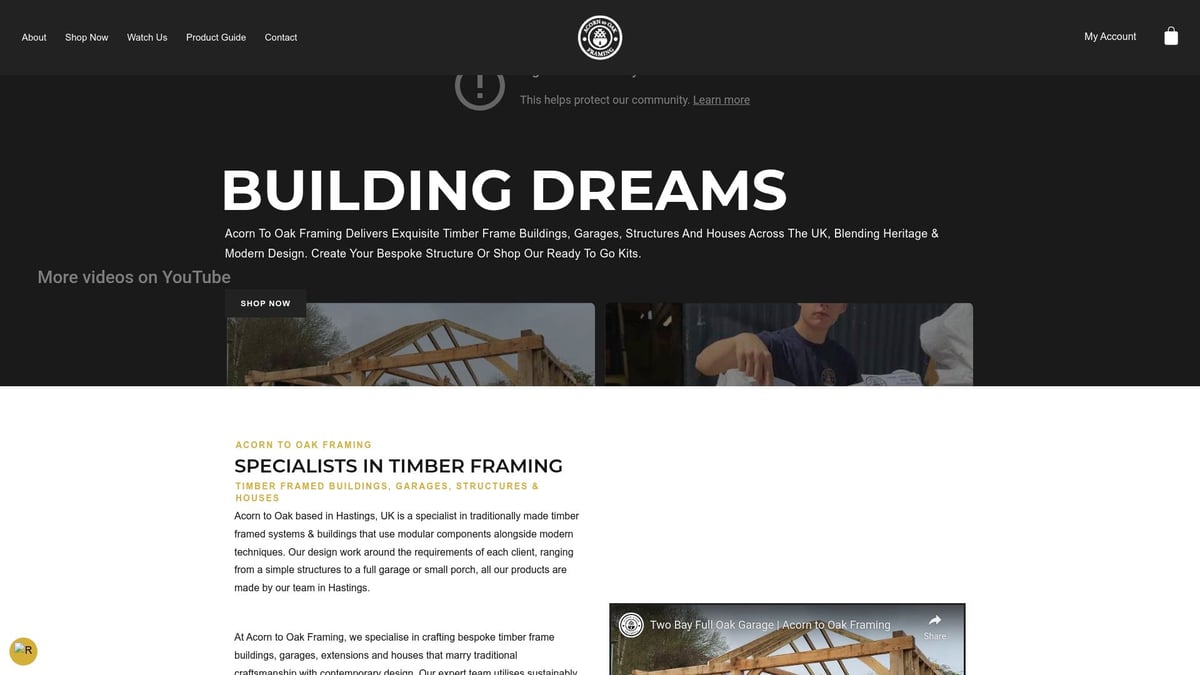
Strict adherence to UK building regulations and up-to-date design practices ensures reliability. Acorn to Oak Framing provides end-to-end support, from initial design through to fabrication, installation, and aftercare. Every timber frame truss delivered is crafted to last for generations.
Material Choices for Timber Trusses: Oak, Softwoods & Engineered Options
Choosing the right material for a timber frame truss is central to both performance and aesthetics. Today’s options balance tradition, innovation, and environmental responsibility. Let’s explore the main choices shaping truss construction in 2025.
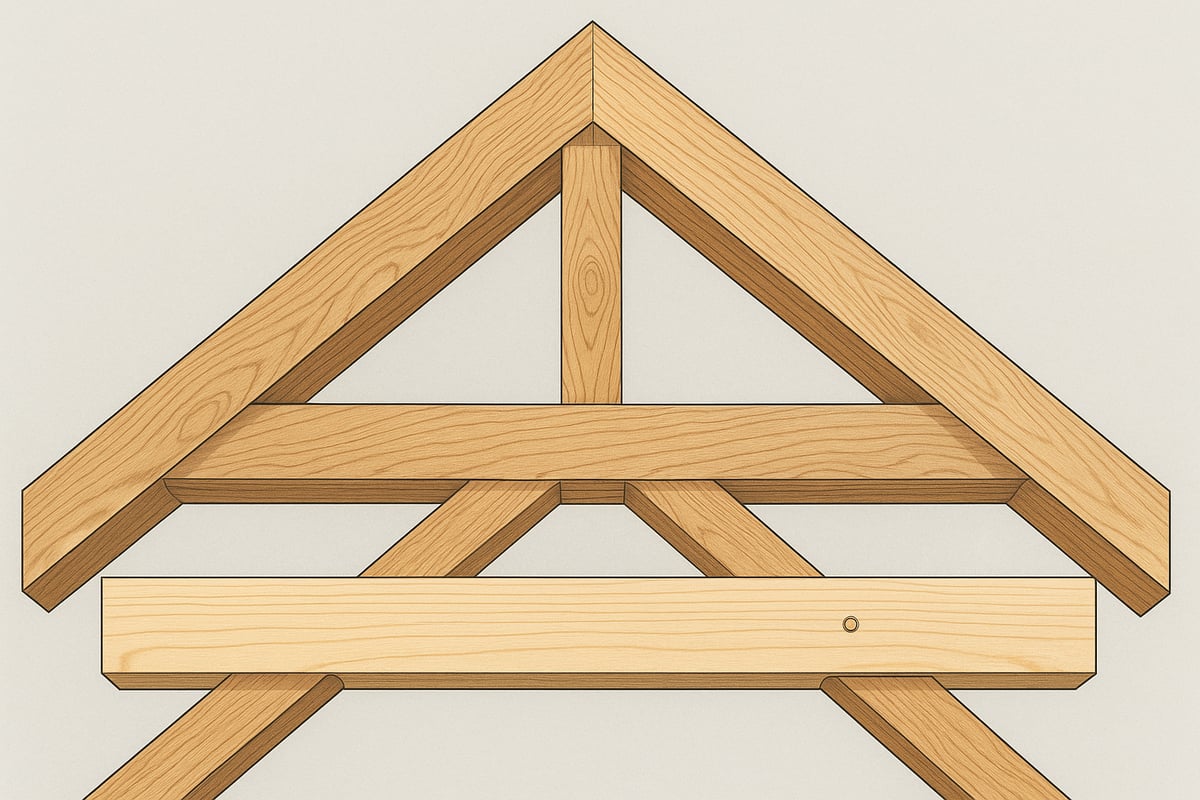
Oak vs. Softwoods: Strength, Sustainability & Aesthetics
Oak stands out in timber frame truss construction for its exceptional strength, durability, and timeless appeal. Its dense grain offers longevity, resisting pests and weathering. In contrast, softwoods like pine and spruce are lighter, easier to work with, and more readily available. Softwoods often suit projects prioritising speed and cost efficiency.
| Feature | Oak | Softwoods (Pine, Spruce) |
|---|---|---|
| Strength | High | Moderate |
| Durability | Excellent | Good |
| Appearance | Rich grain, classic look | Lighter, uniform grain |
| Sustainability | FSC/PEFC options | Widely certified |
Selecting between oak and softwoods for a timber frame truss hinges on project goals, budget, and desired character. Both options can be sourced sustainably, supporting responsible forestry.
Engineered Timber and Hybrid Solutions
Engineered timber products have revolutionised the timber frame truss landscape. Laminated veneer lumber (LVL), glulam beams, and I-joists provide outstanding consistency and strength. These materials are designed for precision, making them ideal for long spans or complex truss shapes.
Combining engineered and solid timber allows for hybrid trusses that maximise performance while maintaining a natural look. Prefabrication with engineered products ensures minimal waste and tight tolerances.
For those interested in the latest breakthroughs, Innovations in Wood Truss Manufacturing 2024 explores how automation and sustainable materials are shaping the future of the timber frame truss industry.
Fasteners, Connectors & Fixings for Timber Trusses
The right fasteners and connectors are vital to the integrity of any timber frame truss. Modern systems rely on screws with high head pull-through capacity, extra-large flange heads, and robust steel brackets. These innovations improve load transfer and reduce the risk of joint failure over time.
Multi-ply screws have become standard for contemporary truss assemblies, providing greater holding power in both oak and softwood. Plates and brackets ensure reliable connections at critical joints, especially where engineered timber is used.
Compliance with updated design requirements guarantees each timber frame truss meets current safety and performance standards.
Material Selection Best Practices for 2025
For 2025, responsible sourcing and future-proofing are top priorities in timber frame truss construction. Always choose timber from FSC or PEFC-certified forests to support sustainable management. Balance cost with structural needs, considering how each material performs over time.
Stay informed about regulatory updates and market trends, as these can affect material availability and standards. Anticipate the shift toward hybrid and engineered solutions for maximum efficiency. By following best practices, every timber frame truss can deliver on quality, sustainability, and design ambitions.
Step-by-Step Guide: Timber Frame Truss Installation & Assembly
Embarking on a timber frame truss project requires precision, coordination, and a clear understanding of each phase. Whether you are building a new home, extension, or commercial space, following a structured approach ensures strength, safety, and compliance. This guide breaks down the essential stages of timber frame truss installation for 2025.
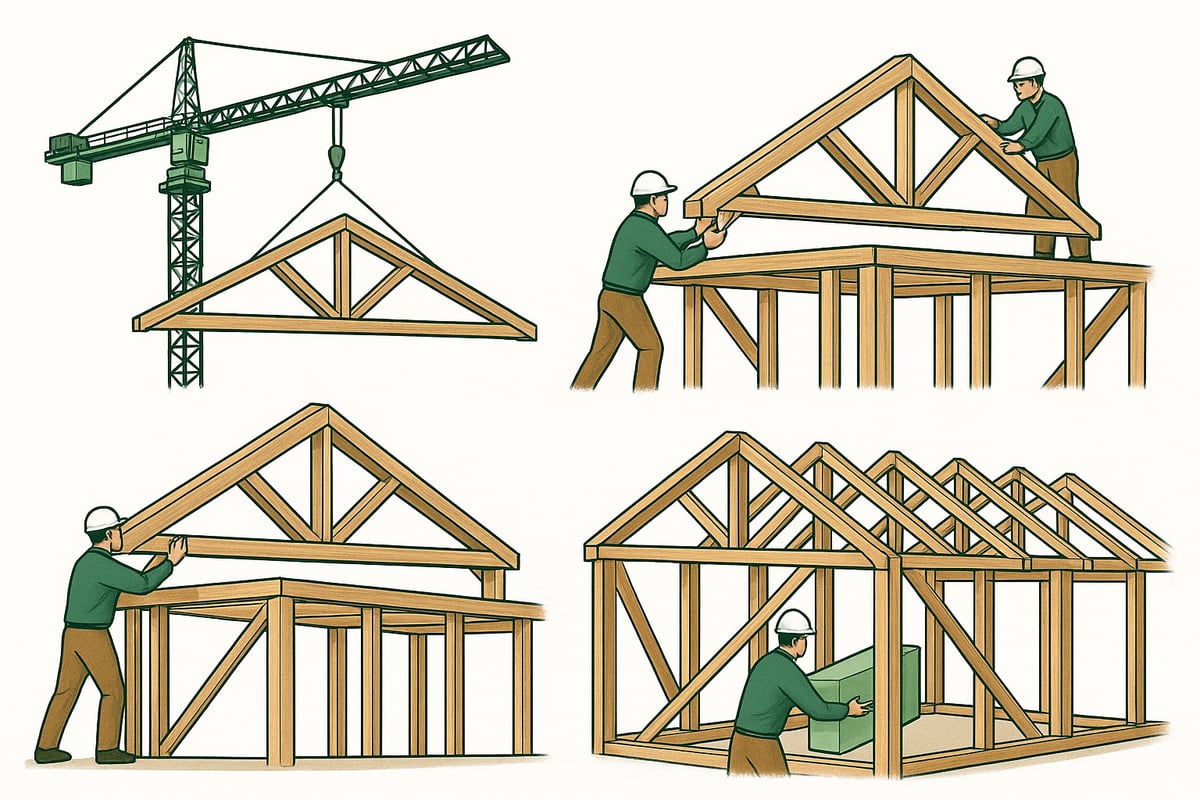
Pre-Construction Planning
Successful timber frame truss installation begins long before any material arrives on site. Start with a thorough site assessment to understand soil conditions and required foundations. Secure all necessary planning permissions and building regulation approvals, especially for projects in the UK where compliance is crucial.
Coordinate delivery schedules for trusses and materials, ensuring storage is dry and level to prevent warping or damage. Review design details and verify all truss dimensions against architectural plans. For a deeper dive into essential pre-construction steps and best practices, see Timber Frame Home Construction. Careful planning at this stage helps avoid costly delays and ensures your timber frame truss project stays on track.
Fabrication and Prefabrication Processes
Fabrication is where timber frame truss components are cut, shaped, and joined. In modern workshops, advanced machinery ensures precision. Craftsmen measure, saw, and finish each truss element, including rafters, tie beams, and webs.
Prefabricated trusses are assembled under controlled conditions, with quality checks at every stage. This approach minimises site errors and speeds up installation. Each truss is labelled for easy identification during transport and assembly. Prefabrication delivers consistent quality and allows for more complex designs, making timber frame truss solutions ideal for both residential and commercial builds.
On-Site Assembly and Erection
Once delivered, timber frame truss units are carefully unloaded and inspected. Assembly begins by lifting trusses into place using cranes or mechanical hoists, ensuring safety and accuracy. Temporary bracing is installed to maintain alignment as each truss is positioned.
Key steps during on-site assembly:
- Position trusses according to layout plans
- Secure with temporary bracing
- Check plumb and alignment before fixing
The timber frame truss system is then fixed to the wall plates or beams, forming the building’s primary structure. Proper handling and installation are vital to maintain structural integrity and meet project specifications.
Connection Details and Fastening Techniques
Strong connections are fundamental to timber frame truss performance. Modern fasteners such as screws, bolts, and plates provide reliable joints, while traditional mortise and tenon joinery may be used for aesthetic or heritage projects. When installing, ensure all fixings have adequate head pull-through capacity, especially in suspended or load-bearing applications.
Use extra-large flange head screws or brackets for multi-ply truss assemblies. Plywood or oriented strand board (OSB) can be added at key junctions for diaphragm action and enhanced stability. Well-designed connections ensure the timber frame truss system withstands both everyday loads and extreme weather events.
Insulation, Airtightness & Waterproofing Integration
Efficient insulation is essential for comfort and energy savings. Integrate structural insulated panels (SIPs) or high-performance insulation boards between and above timber frame truss members. Seal all joints with airtight tapes and membranes to prevent drafts and moisture ingress.
Key considerations:
- Fit insulation snugly between trusses
- Tape and seal all gaps for airtightness
- Use breathable membranes for moisture control
Waterproofing measures, such as vapour barriers and external cladding, protect the structure from rain and condensation. These steps help your timber frame truss building achieve modern energy efficiency standards.
Quality Checks and Building Regulation Compliance
Thorough inspection is required at every stage of timber frame truss construction. Check truss alignment, fixings, and bracing before proceeding to the next phase. Document all quality checks and approvals for future reference.
Ensure full compliance with UK building regulations and structural warranties. Final inspections cover fire safety, insulation, and load-bearing capacity. Proper documentation and client handover complete the timber frame truss installation, ensuring a durable and regulation-compliant structure.
Innovations & Trends in Timber Frame Trusses for 2025
The timber frame truss sector is experiencing a surge in innovation as 2025 approaches. New materials, digital tools, sustainability practices, and regulatory shifts are shaping the way these structures are designed and built. Let us explore the most significant developments redefining timber frame truss construction for the future.
Advanced Materials and Fastening Systems
Recent years have seen remarkable advances in engineered wood products and truss fastening technology. Timber frame truss projects now benefit from laminated veneer lumber (LVL) and glulam, which offer enhanced strength and consistency. Fastening systems have evolved, with multi-ply screws, extra-large washer heads, and optimised thread pitches improving structural integrity for both residential and commercial applications.
A notable development is the introduction of the TBS MAX and TBS SOFTWOOD lines, which provide superior holding power and ease of installation. These innovations ensure that each timber frame truss delivers reliability, efficiency, and longevity, even in complex or large-span designs.
Digital Design, BIM & Prefabrication
Digital transformation is at the core of modern timber frame truss workflows. Building Information Modelling (BIM) and advanced CAD software allow for precise truss geometry, clash detection, and material optimisation before manufacturing begins. Prefabrication benefits from this accuracy, enabling components to be manufactured off-site under controlled conditions.
Automated cutting and assembly processes reduce errors and speed up project timelines. Digital project management tools support seamless coordination between architects, engineers, and builders. As a result, timber frame truss installations are more predictable, cost-effective, and adaptable to bespoke architectural requirements.
Sustainability and Carbon Footprint Reduction
Sustainability is now a driving force in the timber frame truss industry. Timber is a renewable material, and sourcing from certified forests ensures responsible management. Life cycle analysis shows that timber frame truss systems have a lower embodied carbon footprint compared to steel or concrete alternatives.
Manufacturers increasingly use FSC or PEFC-certified timber, supporting ethical supply chains. Prefabrication minimises waste and allows for efficient material usage. The timber frame truss not only supports energy efficiency in finished buildings but also aligns with broader climate and sustainability goals in construction.
Fire Safety, Durability & Longevity
Modern timber frame truss designs incorporate advanced fire safety measures. Treatments and coatings enhance fire resistance, meeting stringent UK building regulations. Engineered wood products are tested for durability, with weatherproofing solutions extending the lifespan of exposed truss elements.
Routine maintenance, such as inspecting joints and reapplying protective finishes, ensures ongoing performance. Innovations in decay prevention and moisture management further reduce risks of rot and degradation. With these measures, a timber frame truss structure can offer decades of reliable service in diverse environments.
Market Outlook & Regulatory Changes for 2025
The outlook for timber frame truss construction is positive as demand grows in both residential and commercial sectors. Regulatory updates in the UK and EU are encouraging the use of sustainable materials and off-site manufacturing. According to Timber Frame Construction Trends UK 2025, government initiatives are accelerating adoption, while new standards emphasise energy efficiency and carbon reduction.
Timber frame truss solutions are set to play a central role in meeting future building needs, combining innovation with compliance and sustainability.
Sustainability & Future-Proofing Timber Frame Truss Projects
Timber frame truss construction is evolving rapidly, with sustainability and future adaptability taking centre stage. As the industry looks toward 2025, building with a timber frame truss means considering not just the present, but also long-term environmental impact, occupant comfort, and the ability to adapt to changing needs over time.
Designing for Longevity and Adaptability
A well-designed timber frame truss structure should stand the test of time while allowing for future modifications. Modular truss systems enable easy upgrades or extensions as requirements change. Preventative maintenance, such as regular inspections and protective treatments, helps ensure durability. By collaborating with designers who understand both traditional and innovative techniques, clients can create timber frame truss solutions that remain flexible for decades. For an in-depth look at blending classic and contemporary approaches, see Timber Frame Hybrid House Insights.
Enhancing Energy Efficiency & Comfort
Integrating high-performance insulation within a timber frame truss can dramatically improve a building’s comfort and efficiency. Properly installed insulation minimises thermal bridging and maintains airtightness, reducing energy bills and enhancing indoor comfort year-round. Timber frame truss designs are compatible with modern solutions, such as SIP panels, which further boost energy performance. Sealing joints with advanced membranes and tapes is also essential for long-term protection against moisture and air leaks.
Sourcing and Certifying Sustainable Timber
Selecting sustainable materials is a fundamental aspect of any timber frame truss project. Always choose timber that is certified by recognised bodies like the FSC or PEFC, ensuring responsible forest management and traceability. Supporting local suppliers can reduce transportation emissions and strengthen regional economies. Transparent sourcing not only benefits the environment but also meets growing regulatory and client demands for ethical construction practices.
Timber Trusses and the Circular Economy
Timber frame truss systems can be designed for disassembly, promoting reuse and recycling at the end of a building’s life cycle. Prefabrication helps reduce on-site waste, while careful planning allows components to be upcycled or repurposed. These circular economy strategies are increasingly important as the market evolves. For insights into long-term trends and the growing role of timber frame truss construction, explore the Roof Truss Market Report 2025-2035.
As you’ve discovered in this guide, timber frame trusses are at the forefront of sustainable design and innovative construction for 2025. If you’re inspired to enhance your property with exquisite craftsmanship and modern engineering—whether it’s a bespoke home, garage, or unique structure—let’s turn those ideas into reality together. At Acorn to Oak Framing, we blend traditional skills with cutting edge solutions, ensuring every project is tailored to your needs and meets UK regulations. If you’re ready to take the next step and discuss your vision with our experts, you can CONTACT US.
